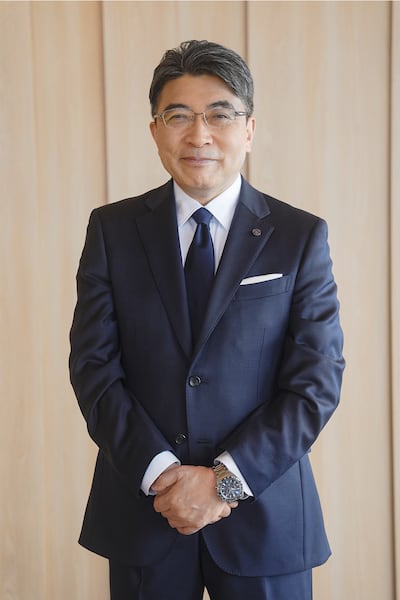
While the Swiss watch industry is battered by the global luxury downturn, one Japanese watchmaking company is reporting an uptick in sales.
According to its latest financial reports, the watch businesses of the Seiko Group Corporation recorded net sales up by 18 percent for its fiscal quarter ending in June, with revenues of 49.9 billion yen ($332.6 million).
This is in stark contrast to Switzerland, where exports of Swiss watches were down 10 percent by volume and 2.5 percent by value in the nine months through September, according to the Federation of the Swiss Watch Industry (FHS).
“Fortunately, I don’t think we’ve been hit by the same luxury segment trend,” says Akio Naito, president of the group’s Seiko Watch Corporation, which oversees the Seiko and Grand Seiko watch brands.
Naito describes Seiko as a premium brand and Grand Seiko as a luxury brand. Retail prices for Seiko watches start from a couple of hundred dollars; Grand Seiko’s collection extends from $2,200 Quartz models to the Kodo, a limited-edition timepiece that costs $365,000.
According to Naito, the spike is due largely to increasing sales of Grand Seiko. Sometimes referred to as “the Japanese Rolex” because it’s a vertically integrated company whose steel sports watches compete at similar price points to those made by the Swiss watchmaking giant, Grand Seiko was founded in 1960 but only launched internationally in 2010.
Naito says the group has been investing heavily in distribution and marketing since 2017 and that Grand Seiko now has around 450 points of sale outside Japan. The world’s largest Grand Seiko boutique opened on Madison Avenue in February.
“Grand Seiko’s recognition has increased tremendously over the past five, six years,” says Naito, noting the emphasis the company has placed on nature and craftsmanship in its watches and communications. Handcrafted details include textural effects birch trees, cherry blossom, seasons…He says he expects to double the size of the brand’s revenues in the next five years.
The corporation does not disclose the individual performance of its watch brands, but Naito admits that a boom in Japan caused by a weak yen and a rush of tourist watch buyers looking to buy Grand Seiko has propped up his company’s performance.
Sales of Grand Seiko in Japan still account for roughly half the brand’s total sales.
“Nobody paid attention to Grand Seiko in 2015,” he says. “But then last year, roughly 20 percent of our domestic sales were generated by inbound tourists, of which the number one nationality [buying watches] is Americans.”
Statistics released by JTB Tourism Research & Consulting Co show visitor numbers to Japan from the US have been up between 25 and 45 percent year-on-year every month for the past six months. Those figures pale in comparison to the influx of Chinese tourists. Since March, Chinese visitor numbers have increased by almost 300 percent a month compared to 2023. Some 745,000 Chinese entered Japan in August alone.
Naito admits surging domestic sales have cannibalised his business in the wider region. “Consumers from neighbouring Asian countries come to purchase Grand Seiko in Japan,” he says. “So all our Asian subsidiaries are actually suffering. But a booming Grand Seiko in Japan compensates for the declining markets.”
In the US and Europe, traditional strongholds for sales of luxury watches, Grand Seiko has not been immune to the downturn. “Our sales were slightly down [in 2023] compared to the previous year, and that trend seems to be continuing into this year,” says Naito. “So in the US and Europe, Grand Seiko is not increasing [its revenues]. In five, six years, the brand had gone up rapidly. Compared to that kind of huge increase every year, the last two years have been very difficult for us.”
As in fashion, Japan has been a rare bright spot for the luxury watch industry this year. According to the FHS, exports of Swiss watches to the country are bucking the global trend, up 10 percent by value year-on-year to the end of September. Exports to China over the same period have collapsed, falling 25 percent by value, equivalent to more than 500 million Swiss francs.
Buyers come to take advantage of the weak yen, as well as Japan’s reputation for clean, safe streets, world-class shopping experiences and unique cultural and fashion landscape. Over the past four years, the yen has lost a third of its value against the dollar, hitting a multi-decade low in early July, making Japan an attractive destination for foreign tourists – and watch buyers.
After installing Shigeru Ishiba as prime minister in September, Japanese voters did not grant a majority to the ruling LFP party in a snap election October 27. Political uncertainty has reversed the yen’s partial recovery in recent months; the perception of Japanese travel and shopping as a relative bargain is likely to persist.
While many customers are seeking out deals on foreign brands, Japanese labels are also getting a boost. Established Japanese fashion brands such as Comme des Garçons, A Bathing Ape and Beams have enjoyed renewed momentum. Watch companies Hublot, Bulgari and Zenith have also recently introduced collaborations with Japanese brands or artists, leveraging the country’s cultural cachet. “Yes, that is certainly an advantage for us,” says Naito.
Many of his Swiss counterparts have raised prices even faster in Japan than in other markets to account for currency fluctuations and to make hay while the domestic sun shines. Naito, by contrast, plans to hold steady on price to remain competitive. ”Their price increases have been so frequent, and that is one of the reasons they are losing sales,” he says of the Swiss brands.
Naito says starting from a low base with Grand Seiko gives him room to believe the company can grow, even while global volumes of luxury watches are in decline.
The brand’s history means it has a deep design archive to call on. Last month, it revived the Grand Seiko 45GS, based on the company’s first automatic watch released in 1968. With the market currently seeing a surge in interest for so-called neo-vintage designs, Naito says his company is well positioned. “It’s to our advantage to have such a heritage and long-term history,” he says. “It’s something we will continue taking advantage of, while constantly innovating our technology.”
But he concedes Grand Seiko has a long way to go before it’s challenging the establishment luxury watch brands in its price segment, such as Rolex, Breitling and IWC. “Outside Japan and the United States, we are still a new brand and not well recognised by mass consumers,” he admits. “We still have a lot to do.”
One issue that remains is consumer confusion between the two brands and the price point disparity. Some Grand Seiko watches, including the new 45GS, still carry the Seiko logo on the dial. “Many points of sale carry both Seiko and Grand Seiko,” Naito notes. “So in the next couple of years we are going to clearly separate them and withdraw Grand Seiko from those points of sale where Seiko is.”
Naito also admits Grand Seiko has not done enough to attract women. “In Japan, roughly 15 percent of Grand Seiko sales are female,” he says. “Outside of Japan it was zero.” He says the company is working to rectify this. “We are now spending far more [on product development and marketing] for the female category [relative to] sales, trying to cultivate the female market.”
Export volumes of Swiss watches have fallen dramatically over the past decade, by almost half, and yet Naito says he is confident Grand Seiko can increase its footprint. “There is a limit to the quantity a brand can command,” he says. “In Switzerland, there are around a dozen brands competing against each other and it is very difficult for one of them to become the size of Rolex. But my perception is that we can develop Grand Seiko to be twice as big [as it is now].”



